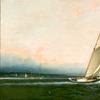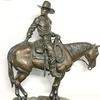Highly Controversial George Grosz Oil at Barridoff Auction on April 30
- PORTLAND, Maine
- /
- April 21, 2014
It came as a surprise to the owners of Barridoff Galleries when initial ads for the upcoming auction of art on April 20 faced censorship not only from the mainstream media but from highly respected daily, weekly, and monthly art publications.
"The final blow came when the printer of our catalogue refused to print it," says Barridoff owner Rob Elowitch. “The sales rep at least gave me the most viable reason: school kids are often taken on tours of the plant." Now, ultimately out of necessity, we practice a bit of censorship ourselves. We use a detail of the painting in question as it is published here." Only online catalogues show the full image. Of course we post those ourselves and no one in the home office of the online companies edits them, it seems.”
The painting is a George Grosz nude - an image that many have considered as strong a statement on the subject as any other by the artist. The detail is difficult enough even before one sees the subtle presence of a fly in the area of the image not shown in the illustration. But Grosz is seen as one of the more important artists of the 20th Century and his work, often bitingly satirical, is seen as historically as well as artistically significant. Few ever combined the two so meaningfully. "Erotica" came from an important private collection. (See below.)
Grosz has famously written, "My drawings and paintings were done as an act of protest: I was trying by means of my work to convince the world that it is ugly, sick, and hypocritical."
It was not a surprise to Annette and Rob Elowitch, proprietors of the auction house, that mainstream publications would not publish the image in full. It was a surprise that art publications. Our printer had the most viable reason: Kids are often on tour of the printing plant."
The first two paragraphs that immediately follow are from the scholarly exhibition and catalogue for George Grosz in Germany, Works on Paper 1913–1925 [earlier than the current lot] at the New York Studio School of Drawing, Painting, and Sculpture, November 7, 2013 – January 4, 2014,
The world Grosz conjured up, populated by mutilated veterans, bullet-headed military types, ladies of the evening, complacent burghers, their scary wives, and the like, is at once repellent and engaging....It’s not pretty but it’s impossible to look away...His penetrating eye is as merciless as his incisive line: no grotesquery, no pomposity, no shade of pretense escaped him. It’s perhaps worth noting that Lucian Freud, himself a connoisseur of the unappetizing, is supposed to have admired Grosz’s drawings.
The truth in all its rawness [is] shown with tenderness by its willingness to be rough...Looking at Grosz’s work, it was impossible not to notice the delicacy (hard word to use in his case) and forcefulness of the stroke. The political position that was the foundation of most of his production, however strong and heartfelt it was, never replaced the artistic rendition. Grosz...remained, in spite of his passion to express his outrage, first and unshakably a fully accomplished artist.
Ralph Jentsch, recognizd Grosz authority: Throughout his career as an artist, Grosz always had a strong liking of erotic subjects. This started as early as in 1912 with his move from Dresden to the metropolis Berlin and culminated in large drawings in the late Twenties and in a series of large works on paper in America It was above all in the years 1939 to 1941 that Grosz partly concentrated his work on the female nude and also erotic subjects again, executing them in pencil, charcoal, watercolor, oil, and mixed media. As mostly always his wife Eva posed for him in the studio but also in nature, mostly in Cape Cod, the fashionable summer resort Grosz started to attend in 1939, spending there two or three months every year, where also this very work was executed. The artist depicts in this work the very moment when the model is nearly completely naked, showing her body quite without shame in all its seductive beauty. Like a sculptor Grosz models the body in every detail, emphasizing the voluptuous beauty of the woman who is ready for love-making. Except for the summer hat and perfume bottle the details of the surrounding are vague and in high contrast to the in all details carefully executed figure of the model that in this way dominates the picture with her beauty. It was only after Grosz had moved to the United States in 1933, that he started working not only with watercolor on paper but also with mixed media and oil, often also using white chalk to outline objects and figures. He only used this painting technique for the many female nudes and highly erotic subjects he started to paint in 1939 and above all in the years 1940 and 1941. The work “Erotica” belongs to this group that within the oeuvre of the artist builds a special work complex of its own kind and importance.
A photo certificate attached verso, dated July 1, 1992 and signed “Richard A. Cohn,” art dealer, executor of the Grosz estate, and son of the important New York collector Erich Cohn, reads as follows: This is to certify that the Woman Erotica oil on paper on this photo is an original by George Grosz - obtained directly from the George Grosz estate with the estate number #UC-337-14.”
The Cohns were strong supporters and friends of the artist. A portrait of Erich Cohn by George Grosz was sold at Christie’s Impressionist and Modern Day Sale in New York on May 9, 2013. A watercolor, The fiddler, sold at Sotheby’s “Impressionist & Modern Art Day Sale” on November 7, 2013, is inscribed “To my old beloved friends Erich and Helene.” Punishment, a watercolor by Grosz, is in the collection of the Museum of Modern Art, a gift of the Erich Cohns in 1934.
A certificate of authenticity recently obtained by Barridoff Galleries from Mr. Jentsch accompanies this lot, which will be included in his catalogue raisonné.
It came as something of a gentle surprise to learn while doing research for this “Erotica” that in the summer of 1949 and again in 1956 Grosz was a teacher at the Skowhegan School of Painting and Sculpture in Maine where the idea for Barridoff Galleries was born under the tutelage of the School’s founder, close friend, and mentor, Willard Cummings.
Contact:
Rob ElowitchBarridoff Galleries
207 772 5011
fineart@barridoff.com







_-Closing-the-Distance_100x100_c.jpg)








